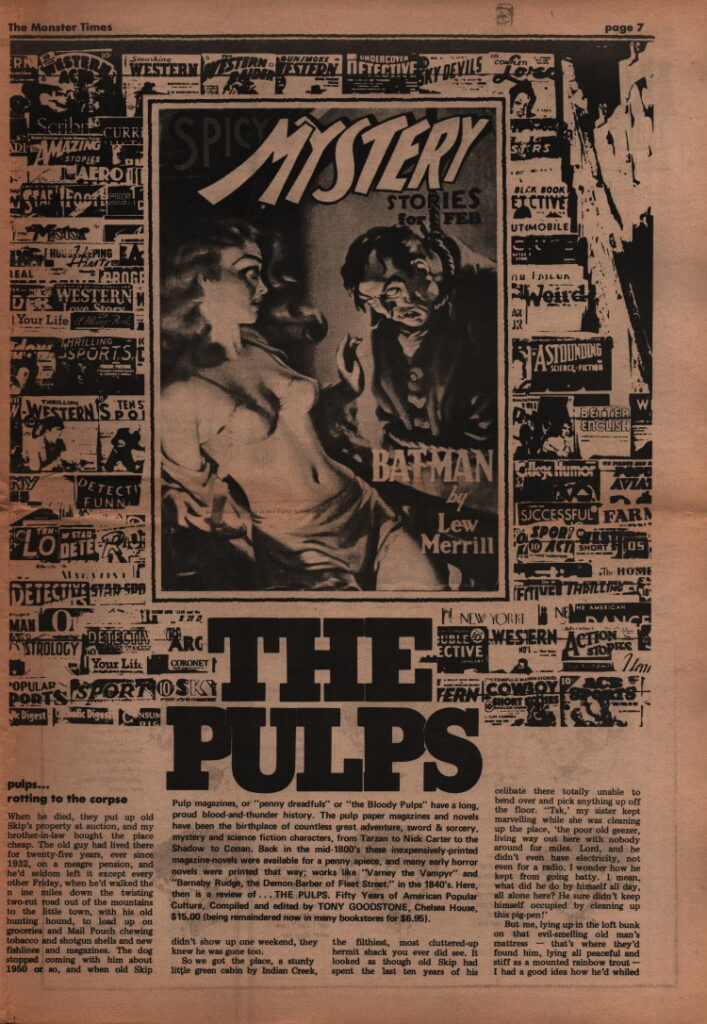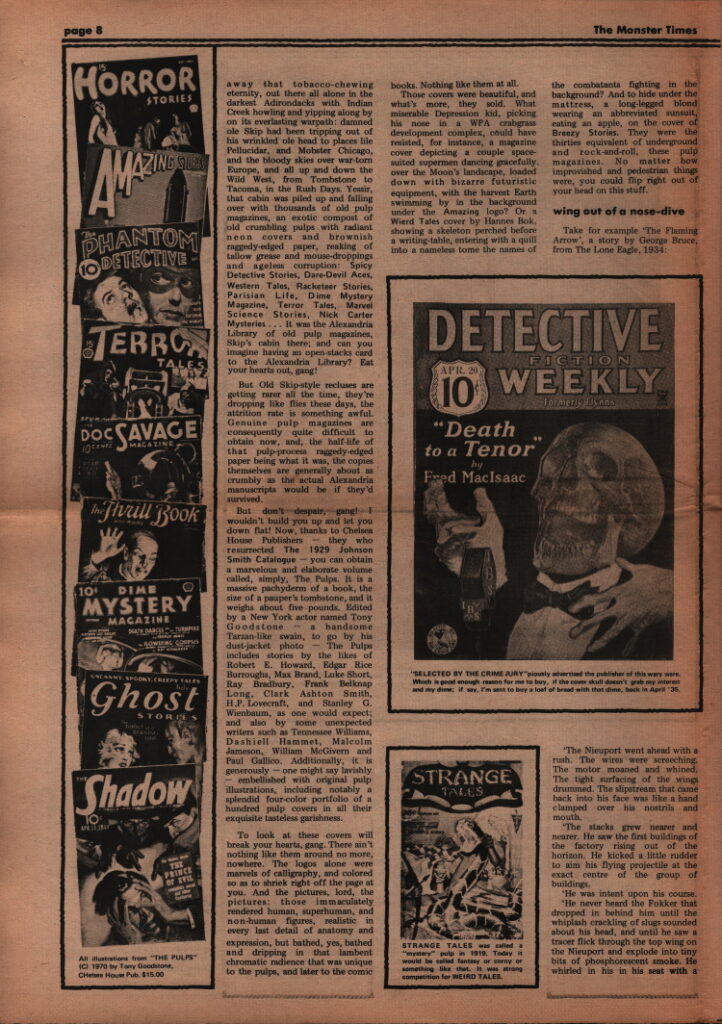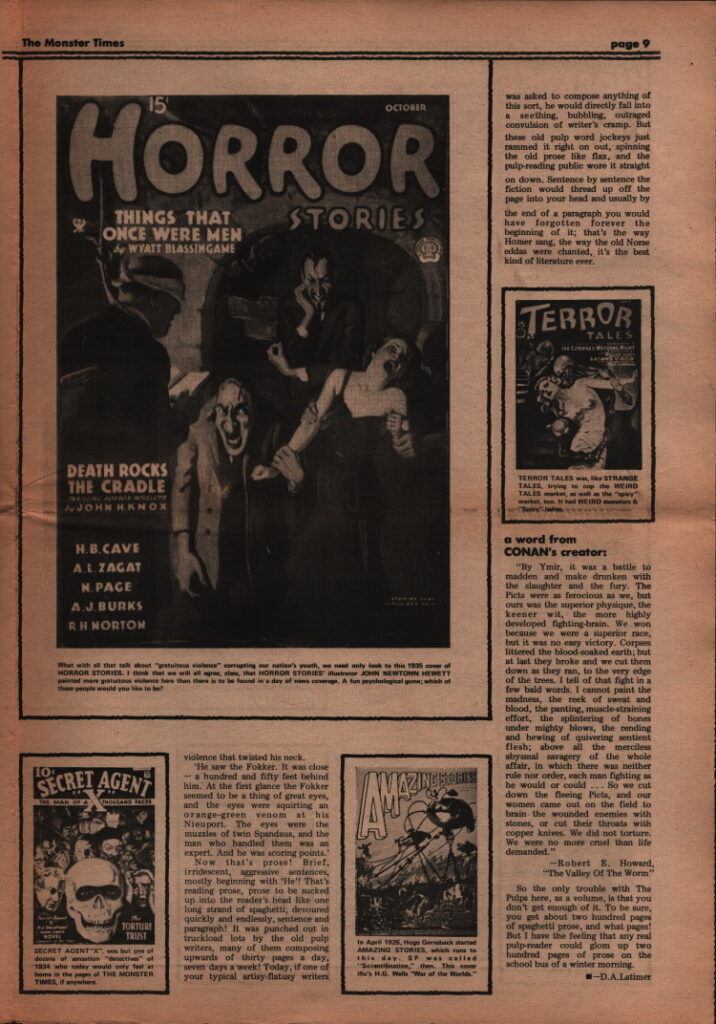
THE PULPS
Pulp magazines, or “penny dreadfuls” or “the Bloody Pulps” have a long, proud blood-and-thunder history. The pulp paper magazines and novels have been the birthplace of countless great adventure, sword & sorcery, mystery and science fiction characters, from Tarzan to Nick Carter to the Shadow to Conan. Back in the mid-1800’s these inexpensively printed magazine novels were available for a penny a piece, and many early horror novels were printed that way; works like “Varney the Vampyr” and “Barnaby Rudge, the Demon-Barber of Fleet Street.” in the 1840’s. Here, then is a review of … THE PULPS. Fifty Years of American Popular Culture, Compiled and edited by TONY GOODSTONE, Chelsea House, $15.00 (being remaindered now in many bookstores for $6.95).
pulps… rotting to the corpse
When he died, they put up old Skip’s property at auction, and my brother-in-law bought the place cheap. The old guy had lived there for twenty-five years, ever since 1932, on a meager pension, and he’d seldom left it except every other Friday, when he’d walked the nine miles down the twisting two-rut road out of the mountains to the little town, with his old hunting hound, to load up on groceries and Mail Pouch chewing tobacco and shotgun shells and new fishlines and magazines. The dog stopped coming with him about 1950 or so, and when old Skip didn’t show up one weekend, they knew he was gone too.
So we got the place, a sturdy little green cabin by Indian Creek, the filthiest, most cluttered-up hermit shack you ever did see. It looked as though old Skip had spent the last ten years of his celibate there totally unable to bend over and pick anything up off the floor. “Tsk,’ my sister kept marveling while she was cleaning up the place, ‘the poor old geezer, living way out here with nobody around for miles. Lord, and he didn’t even have electricity, not even for a radio. I wonder how he kept from going batty. I mean, what did he do by himself all day, all alone here? He sure didn’t keep himself occupied by cleaning up this pig pen!’
But me, lying up in the loft bunk on that evil-smelling old man’s mattress – that’s where they’d found him, lying all peaceful and stiff as a mounted rainbow trout – I had a good idea how he’d whiled away that tobacco-chewing! eternity, out there all alone in the darkest Adirondacks with Indian Creek howling and yipping along by on its everlasting warpath: damned ole Skip had been tripping out of his wrinkled ole head to places lile Pellucidar, and Mobster Chicago, and the bloody skies over war-torn Europe, and all up and down the Wild West, from Tombstone to Tacoma, in the Rush Days. Yessir, that cabin was piled up and falling over with thousands of old pulp magazines, an exotic compost of old crumbling pulps with radiant neon covers and brownish raggedy-edged paper, reaking of tallow grease and mouse-droppings and ageless corruption: Spicy Detective Stories, Dare-Devil Aces, Western Tales, Racketeer Stories, Parisian Life, Dime Mystery Magazine, Terror Tales, Marvel Science Stories, Nick Carter Mysteries … It was the Alexandria Library of old pulp magazines, Skip’s cabin there; and can you imagine having an open-stacks card to the Alexandria Library? Eat your hearts out, gang!

But Old Skip-style recluses are getting rarer all the time, they’re dropping like flies these days, the attrition rate is something awful. Genuine pulp magazines are consequently quite difficult to obtain now, and, the half-life of that pulp-process raggedy-edged paper being what it was, the copies themselves are generally about as crumbly as the actual Alexandria manuscripts would be if they’d survived.
But don’t despair, gang! I wouldn’t build you up and let you down flat! Now, thanks to Chelsea House Publishers they who resurrected The 1929 Johnson Smith Catalogue – you can obtain a marvelous and elaborate volume called, simply, The Pulps. It is a massive pachyderm of a book, the size of a pauper’s tombstone, and it weighs about five pounds. Edited by a New York actor named Tony Goodstone – a handsome Tarzan-like swain, to go by his dust-jacket photo – The Pulps includes stories by the likes of Robert E. Howard, Edgar Rice Burroughs, Max Brand, Luke Short, Ray Bradbury, Frank Belknap Long, Clark Ashton Smith, H.P. Lovecraft, and Stanley G. Wienbaum, as one would expect; and also by some unexpected writers such as Tennessee Williams, Dashiell Hammet, Malcolm Jameson, William McGivern and Paul Gallico. Additionally, it is generously-one might say lavishly – embellished with original pulp illustrations, including notably a splendid four-color portfolio of a hundred pulp covers in all their exquisite tasteless garishness.
To look at these covers will break your hearts, gang. There ain’t nothing like them around no more, nowhere. The logos alone were marvels of calligraphy, and colored so as to shriek right off the page at you. And the pictures, lord, the pictures: those immaculately rendered human, superhuman, and non-human figures, realistic in every last detail of anatomy and expression, but bathed, yes, bathed and dripping in that lambent chromatic radiance that was unique to the pulps, and later to the comic books. Nothing like them at all.
Those covers were beautiful, and what’s more, they sold. What miserable Depression kid, picking! his nose in a WPA crabgrass development complex, could have resisted, for instance, a magazine cover depicting a couple spacesuited supermen dancing gracefully. over the Moon’s landscape, loaded down with bizarre futuristic equipment, with the harvest Earth swimming by in the background under the Amazing logo? Or a Wierd Tales cover by Hannes Bok, showing a skeleton perched before a writing table, entering with a quill into a nameless tome the names of the combatants fighting in the background? And to hide under the mattress, a long-legged blond wearing an abbreviated sunsuit, eating an apple, on the cover of Breezy Stories. They were the thirties equivalent of underground and rock-and-roll, these pulp magazines. No matter how improvished and pedestrian things were, you could flip right out of your head on this stuff.
wing out of a nose-dive
Take for example “The Flaming Arrow’, a story by George Bruce, from The Lone Eagle, 1934:
The Nieuport went ahead with a rush. The wires were screeching. The motor moaned and whined. The tight surfacing of the wings drummed. The slipstream that came back into his face was like a hand clamped over his nostrils and mouth.
‘The stacks grew nearer and nearer. He saw the first buildings of the factory rising out of the horizon. He kicked a little rudder to aim his flying projectile at the exact center of the group of buildings.
‘He was intent upon his course.
‘He never heard the Fokker that dropped in behind him until the whiplash crackling of slugs sounded about his head, and until he saw a tracer flick through the top wing on the Nieuport and explode into tiny bits of phosphorescent smoke. He whirled in his in his seat with a violence that twisted his neck.

“He saw the Fokker. It was close – a hundred and fifty feet behind him. At the first glance the Fokker seemed to be a thing of great eyes, and the eyes were squirting an orange-green venom at his Nieu port. The eyes were the muzzles of twin Spandaus, and the man who handled them was an expert. And he was scoring points.’
Now that’s prose! Brief, iridescent, aggressive sentences, mostly beginning with ‘He’! That’s reading prose, prose to be sucked up into the reader’s head like one long strand of spaghetti, devoured quickly and endlessly, sentence and paragraph! It was punched out in truckload lots by the old pulp writers, many of them composing upwards of thirty pages a day, seven days a week! Today, if one of your typical artisy-flatusy writers was asked to compose anything of this sort, he would directly fall into a seething, bubbling, outraged convulsion of writer’s cramp. But these old pulp word jockeys just rammed it right on out, spinning the old prose like flax, and the pulp-reading public wore it straight on down. Sentence by sentence the fiction would thread up off the page into your head and usually by the end of a paragraph you would have forgotten forever the beginning of it; that’s the way Homer sang, the way the old Norse Eddas were chanted, it’s the best kind of literature ever.
a word from CONAN’s creator:
“By Ymir, it was a battle to madden and make drunken with the slaughter and the fury. The Picts were as ferocious as we, but ours was the superior physique, the keener wit, the more highly developed fighting brain. We won because we were a superior race, but it was no easy victory. Corpses littered the blood-soaked earth; but at last they broke and we cut them down as they ran, to the very edge of the trees. I tell of that fight in a few bald words. I cannot paint the madness, the reek of sweat and blood, the panting, muscle-straining effort, the splintering of bones under mighty blows, the rending and hewing of quivering sentient flesh; above all the merciless abysmal savagery of the whole affair, in which there was neither rule nor order, each man fighting as he would or could … So we cut down the fleeing Picts, and our women came out on the field to brain the wounded enemies with stones, or cut their throats with copper knives. We did not torture. We were no more cruel than life demanded.”
-Robert E. Howard,
“The Valley Of The Worm”
So the only trouble with The Pulps here, as a volume, is that you don’t get enough of it. To be sure, you get about two hundred pages of spaghetti prose, and what pages! But I have the feeling that any real pulp reader could glom up two hundred pages of prose on the school bus of a winter morning.
-D.A. Latimer
